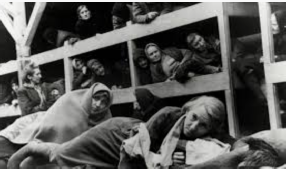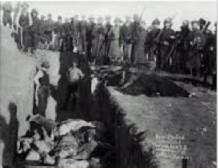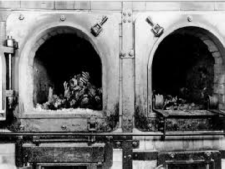|
CLICK BUTTON TO GO |
|
|
|
|
|
|
|
|
|
|
|
|
|
Videos |
|
|
|
|
|
|
|
|
|
|
|
|
|
PART 1 T O P I C |
|
|
|
|
|
|
|
|
|
|
|
|
|
|
|
|
|
|
JewishWikipedia.info
SURVIVING SURVIVAL:
JAMES G. MCDONALD
AND THE FATE OF HOLOCAUST SURVIVORS
Norman J.W. Goda
United States Holocaust Memorial Museum, 2014
After World War II, a bitter argument broke out concerning the fate of Jewish refugees. In the late summer of 1945, some 70,000 Jewish survivors of the Nazis’ Final Solution were living in camps run by the United Nations Relief and Rehabilitation Administration in occupied Germany, Austria and Italy. As the months passed, they were joined by a steady stream of Jewish refugees from the east, primarily Poland and Romania, who had been terrorized by individual acts of violence and even full-blown pogroms.1 Aided by an underground Zionist organization called the Bricha and the quiet cooperation of the Soviet authorities, they made their way west in small groups, sometimes at the rate of 100–500 a day. By late 1946, perhaps a quarter million Jews were in hundreds of displaced persons (DP) camps and other facilities in Germany, Austria, and Italy alone.
What to do with them became a contentious issue. The United Nations Relief and Rehabilitation Administration (UNRRA), which ran the camps in Allied-occupied areas in conjunction with Allied military authorities and with the help of charitable organizations, provided repatriation services for non-Jewish DPs. But Jewish refugees did not want repatriation. They hoped to leave Europe entirely; for most, the preferred destination was Palestine. For the Jewish leaders in Palestine itself, particularly the Jewish Agency under David Ben-Gurion, there was no other solution. The Shoah confirmed all Zionist arguments concerning Jewish safety in the Diaspora and the need for a Jewish state. For millions in the United States, the Zionists had a point. Influenced by basic humanity, American Zionist arguments, and political considerations, President Harry S. Truman called publicly in September 1945, if not for a Jewish state, then for the admission into Palestine of 100,000 Jewish refugees, the number then thought to be in the DP camps. A congressional resolution in December called for unlimited immigration and a Jewish commonwealth there.
The British, who controlled Palestine, thought otherwise. In the 1917 Balfour Declaration, the British government promised to use its best efforts to establish a Jewish home in Palestine, and in 1922 it received a League of Nations mandate to do so. Arab anger and sporadic violence resulted in redefinitions of the promise until in May 1939, with war looming in Europe, the British issued a White Paper that capped future Jewish immigration into Palestine at 75,000. Britain’s global position depended on its strategic presence in the Middle East, namely control of the Suez Canal zone, naval and air bases in Egypt and Iraq, plus railroads, oil concessions, and pipelines. In July 1945, Britain was weakened, broke, and facing a rising tide of Arab nationalism. The new Labour government and its new Foreign Secretary Ernest Bevin, saw that London had to convert its old imperial dominance into strategic partnerships with the Arab world. More Jews in Palestine could make this task impossible. The fundamentals of the White Paper were thus to be maintained. Jewish DPs were to return home. Britain even hoped to dissolve the Jewish Agency and the Haganah, the Jewish militia, owing to their toleration of the extremist tactics of the Irgun Zvai Leumi and to their own challenges to the government’s immigration policies.
This paper examines the problem of Jewish refugees through the lens of a short-lived body called the Anglo-American Committee of Inquiry Regarding the Problems of European Jewry and Palestine, and also through the eyes of the man who became its most important member, James G. McDonald. The British could not afford a rupture with Washington over the growing mass of Jewish DPs or Palestine’s future. In November 1945, Bevin thus proposed a joint Anglo-American Committee to undertake a full examination of the issue of Jewish refugees and where they might go. On the White House’s insistence, Bevin included the question of Palestine in the Committee’s charge. Still, he expected favorable answers to a number of key questions. Did the great mass of Jews really want to go to Palestine, or was a militant Zionist leadership simply manipulating them? Could they just as easily return home to Poland and elsewhere? Could Palestine economically support mass immigration from Europe? What would the Arab and Muslim reaction be? The committee was to make an extensive study by hearing testimony in Washington, London, Europe, and the Middle East, and then make recommendations to both governments.
Committee studies of Palestine were nothing new. They had been happening since the Mandate began. But this committee was the first to study the Palestine issue after the Holocaust. It was the first to do so in light of Britain’s badly weakened postwar position within its empire. And it was the first to include the Americans. Thus it was believed in many quarters that this committee would be the committee that would emerge with definitive recommendations to a thirty-year-old problem. Most everyone who was anyone was heard. On the Zionist side Chaim Weizmann, David Ben-Gurion, Golda Meyerson, and many more testified, as did ordinary Jews throughout DP camps in Western Europe. On the Arab side, witnesses included monarchs, statesmen, scholars, and agitators. British military officers and colonial officials also testified in closed sessions to explain the military implications as they saw them. Bevin, meanwhile, believed that including the Americans was a stroke of brilliance. They would be shown the practical realities. In this connection he also was confident that the US appointees would come from the Department of State’s Office of Near Eastern and African Affairs, which included seasoned US diplomats who understood the strategic significance of the Middle East, had grown increasingly annoyed with Zionist pressure, and thus shared London’s view of the problem. The Committee’s recommendations thus would outflank the pro-Zionists in the US and even the White House. As Gordon Merriam of the Division of Near Eastern Affairs put it, the Committee was expected “to knock over a number of Zionist contentions….” As Bevin put it when announcing the Committee in parliament, “I will stake my political future on solving this problem.”
James G. McDonald wanted to be a member of this committee. McDonald was a scholar transplanted from Indiana to New York. In the 1920s he had chaired the Foreign Policy Association, a study group concerned with multilateralism and that favored working with the League of Nations. After Hitler’s rise to power in 1933, McDonald became League of Nations High Commissioner for Refugees. In this position he met leaders from Hitler to Roosevelt. After two years of failing to convey that German Jews were in lethal danger, he resigned in protest. Until 1945, he tried to help Europe’s Jews, doing so in numerous capacities: as a delegate to the Evian Conference, as a member of the President’s Advisory Commission on Refugees, and on the editorial board of the New York Times. He developed numerous connections with American and British Jewish leaders, and a belief in Zionism—the idea of a secular Jewish peoplehood and that this people needed a homeland. Most of his diaries and a significant part of his papers, lost for many years, now are in the archive of the United States Holocaust Memorial Museum.
To read pages 3-14 go to
SURVIVING SURVIVAL:
JAMES G. MCDONALD AND THE FATE OF HOLOCAUST SURVIVORS …................................................
BOTTOM OF P14 Section VII
The 100,000 did not travel to Palestine, at least not yet; and indeed, by the summer of 1946, more than twice that number waited in Europe to emigrate. But the larger point was this: the Anglo-American Committee and Truman’s subsequent support of its plan represented a significant and very open break with the British over the fundamental issue of Jews, in this case Holocaust survivors, immigrating to Palestine with fewer restrictions. This had never happened before. Without US support, or at least the irritated acquiescence that London needed on the issue, Britain could not square the circle between a more violent Jewish insurgency in Palestine, more Jews trying to arrive on Haganah-financed ships, and growing Arab anger. In February 1947 the British turned the matter over to the United Nations, the UN voted for partition in November 1947, and the Israeli declaration of independence followed the day before the British Mandate officially ended—on May 14, 1948. Jewish refugees who wanted to go to the new state eventually did so, and the state of Israel doubled in population over the next ten years.
The culmination of McDonald’s career still lay ahead. For now he received accolades from everyone who cared about the refugee issue. As he wrote Eddie Cantor on August 6, 1946:
I had a long and, I think, useful interview with President Truman on Saturday, July 27…. After the conference, at which the President and I did most of the talking, Senators Wagner and Mead, who were my sponsors, told the [American] Zionist Emergency Council that they had never heard a more frank and effective presentation to the President. Well, I had nothing to lose save honor, so I let him have it straight.70
Truman, however irritated he might have become, liked it straight. The day after the new state of Israel declared its independence, Truman infuriated the State Department again by making the US the first country to recognize Israel. In searching for a proper ambassador, he chose McDonald, the same man at whom he yelled almost exactly two years before. McDonald served as the first US ambassador in Israel for two and a half years, helping to build a special relationship that did not exist between Israel and any other country. But this is a story for another volume, and perhaps, another lecture.
VIDEO - SURVIVORS
SURVIVING SURVIVAL OF HOLOCAUST SURVIVORS



THE
INCREDIBLE
STORY OF THE JEWISH PEOPLE
THE NAZI OFFICER'S WIFE
Niky Dimitrov 2015 (1.37.25)
How One Jewish Woman Survived the Holocaust is a 1999 autobiography by Austrian-born Edith Hahn-Beer. Written with the help of Susan Dworkin, the book's first edition was published by Rob Weibach Books and William Morrow and Company. A documentary film based on the source material and starring Hahn-Beer herself was released in 2003.
DAY IN AUSCHWITZ 2015
Holocaust Concentration Camp Documentary Auschwitz 2015 (47.32)
Documentary that follows 89-year-old Holocaust survivor Kitty Hart-Moxon's poignant return to the former Nazi death camp where she was sent 70 years earlier, with her mother, at the age of 16.
SURVIVORS OF THE HOLOCAUST
Journeyman Pictures 2016 (28.37)
The life-stories of ten survivors of the Holocaust in Lithuania, where 95% of the pre-war Jewish population
was destroyed.
'In my town they buried people alive and built a warehouse on top of them' remembers Berl. Those who survived did so because they joined the partisans or the army, or escaped to Russia. Or because kind strangers hid them in basements and attics and on farms, because they slipped unnoticed through a hole in the ghetto gate or crawled out through a sewer, or somehow lasted in the camps until liberation. Chasia, now 87, got a visit late one night by friends who told her to flee immediately. 'I could leave my children behind and save myself..or try to save them' she says
'my decision has tortured me all my life'.
SURVIVOR TESTIMONY: RESIST-ANCE IN AUSCHWITZ-BIRKENAU
Claire Heymann
HMTC 2015 (20.23)
Claire Heymann was born in Germany in 1924. During Kristallnacht, her home was destroyed by Nazi Stormtroopers, and her father was imprisoned in Dachau concentration camp. In 1941, Ms. Heymann was arrested by the Gestapo and sent as a slave laborer to a Siemens airplane factory in Berlin. Her parents were deported to Lublin and murdered in Majdanek. In 1943, she was forced into a cattle car and sent to Auschwitz-Birkenau. While assigned to the munitions factory of Weichsel-Union-Metallwerke, Ms. Heymann shared a bunk with Hanka and Ester Wajcblum. Ester Wajcblum, Ella Gartner, Regina Safirsztain, and Roza Robota were members of the Resistance movement in Auschwitz who assisted in the destruction of a crematorium during the revolt of October 7, 1944. The four women were captured, tortured, and as a prisoner in Auschwitz, Ms. Heymann was forced to witness their execution. In 1947, she immigrated to New York. Today, she is proud to be the mother of three daughters and six grandchildren.
Ms. Heymann gave her testimony as part of the HMTC conference, "Generations" which took place on June 8, 2014, at Hofstra University.

EVA KOR - SURVIVOR OF THE HOLOCAUST AND NAZI EXPERIMENTS ON TWINS
Because I said I would (2015) (22.50)
Her story begins with a number: A-7063. It is tattooed on her arm. Eva Kor is a Holocaust survivor who endured the Dr. Josef Mengele's twin experiments at Auschwitz. In 1944, Eva's family was packed into a cattle car and transported to the Auschwitz death camp. After 70 hours without food or water, Eva and her family emerged onto the selection platform at Auschwitz. Eva's parents and two older sister were selected to be killed immediately. Eva and her twin sister Miriam were saved to be experimented on. Approximately 1500 sets of twins-3000 children-were abused, and all but 200 died as a result of these experiments. Eva herself became deathly ill, but through sheer determination, she stayed alive and helped Miriam survive. This is a picture of Eva and her sister being freed from the Nazis (the two in stripes). As they grew older, Miriam's kidneys would fail, requiring a transplant. Committed to the survival of her sister, Eva donated a kidney to her.
This speech was filmed at because I said I would | ONE in Columbus, Ohio on September 6th, 2014. Because I said I would is a social movement and nonprofit dedicated to the betterment of humanity through promises made and kept.
Visit: http://www.becauseisaidiwould.com
AUSCHWITZ SURVIVORS REUNITED
70 YEARS ON
BBC News, 27 Jan 2015 (4.07)
Exactly 70 years ago today, the Auschwitz concentration camp in Poland was liberated by Soviet soldiers. It was the largest camp established by Germany during World War 2 - and its name is forever associated with the Nazi plan to wipe out Europe's Jewish population. More than a million people, the vast majority of them Jews, were killed there.
SURVIVOR TESTIMONY:
ESCAPING THE AUSCHWITZ GAS CHAMBERS -
Rachel Gleitman
HMTC Dec 2014 (14.50)
Rachel (Rae) Gleitman was born in Muncacs Czechoslovakia in 1923. In 1939, the Germans sent her brother to labor brigade at the battlefront. She and the rest of her family were forced onto cattle cars and deported to Auschwitz-Birkenau. In January 1945, as the Soviets approached Auschwitz, she and other prisoners were sent on a death march. She and a dozen young women escaped from the march. Ms. Gleitman first returned to her hometown, then to Prague and finally to a displaced persons (DP) camp in Germany. She taught Hebrew in the DP camp and married. Ms. Gleitman is featured in the documentary, "Paperclips." She spoke about escaping the Auschwitz Gas Chambers at the HMTC conference, "Generations," which took place on June 8, 2014 at Hofstra University.
SURVIVOR TESTIMONY: SURVIVING BERGEN-BELSEN:
Marion Blumenthal Lazan
HMTC
Published on 8 Jan 2015
Following Hitler's rise to power, the Blumenthal family - father, mother, Marion, and her brother, Albert, were trapped in Nazi Germany. They managed eventually to get to Holland, but soon thereafter it was occupied by the Nazis. For the next six and a half years the Blumenthals were forced to live in refugee, transit, and prison camps that included Westerbork in Holland and the notorious Bergen-Belsen in Germany. Though they all survived the camps, Walter Blumenthal, Marion's father, succumbed to typhus just after liberation.
It took three more years of struggle and waiting before Marion, Albert and their mother at last obtained the necessary papers and boarded ship for the United States. Their story is one of horror and hardship, but it is also a story of courage, hope and the will to survive.
Marion spoke at the HTMC conference, "Generations," which took place June 8, 2014 at Hofstra University.
WITNESS: VOICES FROM THE HOLOCAUST (
HVT-8076)
Yale University 2009 (1.27.11)
Nineteen first-person accounts of witnesses, including Jews, non-Jews, American POWs, GIs who first entered the camps, a member of the Hitler youth, a Jesuit priest, resistance fighters, and child survivors are woven into a single narrative of World War II and the Holocaust. They tell stories of life under the Nazis, the ghettos, concentration and death camps, liberation, and the challenges they faced after the Holocaust. Includes some documentary footage with graphic violence and detailed descriptions of violence.
